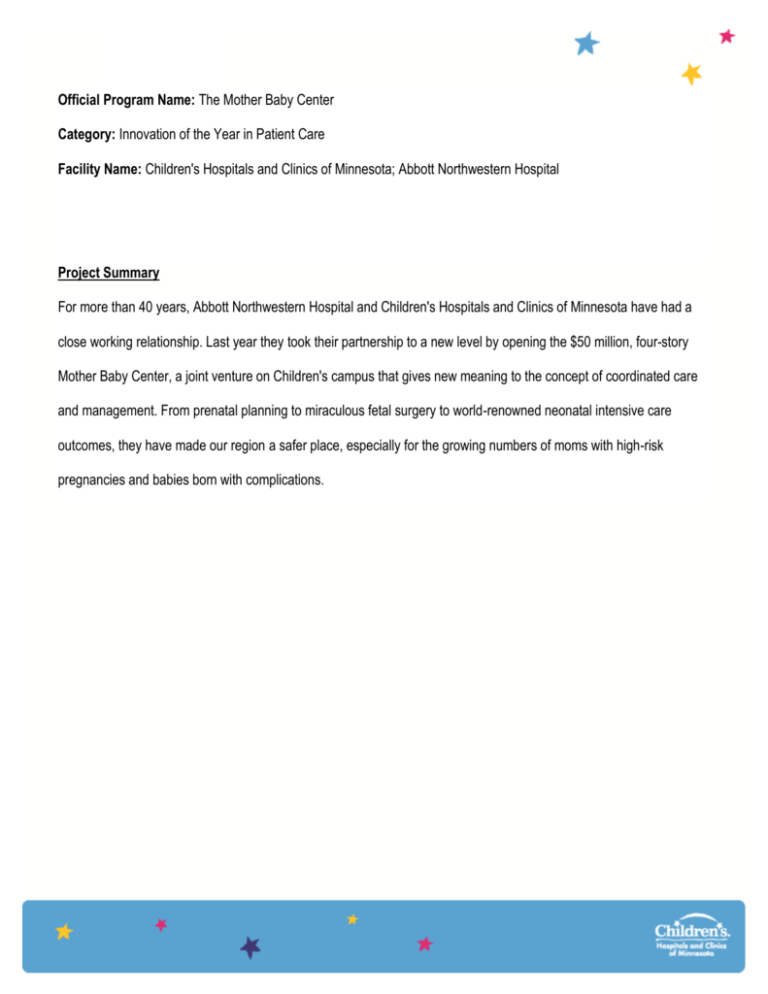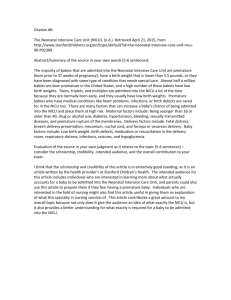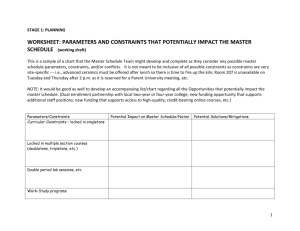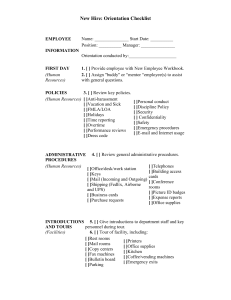Official Program Name: The Mother Baby Center Category
advertisement

Official Program Name: The Mother Baby Center Category: Innovation of the Year in Patient Care Facility Name: Children's Hospitals and Clinics of Minnesota; Abbott Northwestern Hospital Project Summary For more than 40 years, Abbott Northwestern Hospital and Children's Hospitals and Clinics of Minnesota have had a close working relationship. Last year they took their partnership to a new level by opening the $50 million, four-story Mother Baby Center, a joint venture on Children's campus that gives new meaning to the concept of coordinated care and management. From prenatal planning to miraculous fetal surgery to world-renowned neonatal intensive care outcomes, they have made our region a safer place, especially for the growing numbers of moms with high-risk pregnancies and babies born with complications. Scope, Originality and Implementation Abbott Northwestern Hospital and the Minneapolis campus of Children’s Hospitals and Clinics of Minnesota are located next to each other on Chicago Avenue and have had a close working relationship for 40 years. Throughout this time, babies born at Abbott who required specialized neonatal care were rushed via a quarter-mile tunnel to Children’s. The organizations saw an opportunity to bring a more innovative, patient-centered focus to their already strong maternal-fetal and neonatology care programs. Together, they integrated the maternal, fetal and obstetric services of Abbott with the highly-specialized neonatal intensive care service (NICU) of Children’s into one unit and care model to create The Mother Baby Center (TMBC), a new, 96,000-square-foot, four-story facility. Only a handful of similar, comprehensive programs exist, and none in Minnesota. TMBC has three aims: top-tier clinical performance, targeted efficiencies to make care affordable and focused attention across the care spectrum, starting with prenatal planning through pregnancy, childbirth and newborn care for both low- and high-risk deliveries. The Level III NICU and special care nursery (SCN) for less-acute premature babies are now steps away from birthing rooms, meaning high-risk infants have a better chance at survival and no longer must be separated and cared for away from their mothers. Allina and Children's conceived TMBC as a scaled, specially equipped response to the rising incidence of complications related to prematurity, low birth weight and other factors such as advanced maternal age, obesity and congenital defects. Both moms and babies in this group have special needs. Approximately 10 to 12 of every 100 births at TMBC require the SCN, infant care center or NICU. TMBC accordingly features the following: 13 labor and delivery rooms, larger patient rooms and a dedicated room for water births; Three operating rooms, one of which is significantly larger, to allow for complex surgeries and multiples as well as in-utero fetal surgeries; 24/7 maternal assessment center for expectant mothers with concerns about their pregnancy; Family sleep rooms for parents whose babies need to stay after the mother is discharged; Enhanced family-centered features such as a celebration plaza, interfaith chapel, healing garden and large open areas where families can relax. TMBC was built in approximately 2 years, on time and on budget. It opened on Feb. 4, 2013 in a new structure adjoining Children's. Demonstrated Effectiveness in Achieving a Stated Purpose The NICU’s proximity to birthing rooms has decreased transport time from 6 or 7 minutes to only 30 seconds, allowing for more time within the child’s first hour of life – referred to as the “golden hour” because of its impact on infant outcomes. The availability of private SCN rooms as an alternative to private NICU rooms has resulted in a lower daily room charge, more appropriate RN staffing and a better family experience. Deliveries in 2013 exceeded projections with 5,153 in 11 months — a 23% increase over 2012. Potential for Applicability to Other Hospitals Children’s and Allina plan to expand their successful partnership. Further integration will enable creation of a powerful mother-baby database to deepen providers' understanding, helping them to create a replicable model of better outcomes for high-risk babies. Similarly, results achieved in this high-volume environment should influence prenatal care and pregnancy outcomes. And just as Children’s neonatal care model has helped improve outcomes around the world, the new mother baby model and research will be packaged and shared so that others can achieve the same outcomes.








